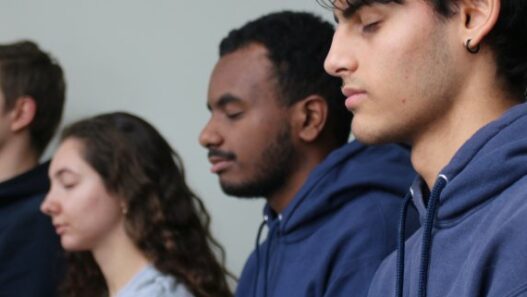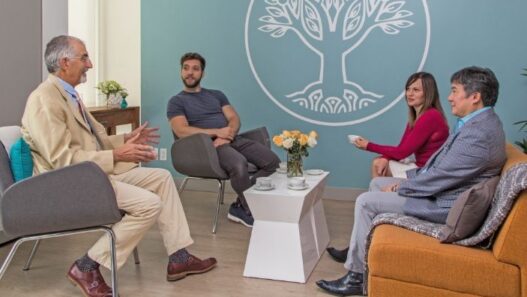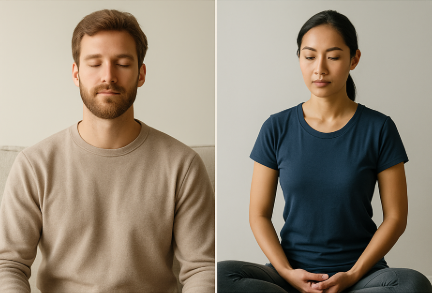If you’re here, you’re probably juggling a career, relationships, health, and an inbox that somehow grows overnight. You don’t want a hobby. You want a practice that reliably lowers stress, lifts your mood, and sharpens your mind—without feeling like another chore. I’ve tried Mindfulness. I’ve practiced Transcendental Meditation (TM). I’ve pored over the research and listened to people whose lives genuinely changed. Both methods have merit. But if you’re asking which one most people find easier to keep—and faster to feel—TM keeps coming out ahead.
Let me show you why, and introduce you to people you’ve heard of (and some you haven’t) whose stories are on the record.
Two techniques in plain English
Mindfulness is moment-to-moment awareness. You sit, notice your breath or body sensations, and when your mind wanders (which it will), you kindly escort attention back to the present. Over time, that training builds steadiness and emotional regulation. High-quality research backs meaningful benefits for anxiety, stress, and mood, particularly in structured courses like MBSR—Mindfulness-Based Stress Reduction. (PMC, ScienceDirect, Nature)
Transcendental Meditation is different. You’re taught one-on-one by a certified teacher and use a personalized sound (mantra) for about 20 minutes, twice a day. The technique is deliberately effortless—no monitoring, no controlling thoughts. That ease helps the mind settle inward to a quiet, restorative state linked with measurable physiological rest and changes in brain dynamics. (PubMed)
If Mindfulness is gently steering your attention to the surface, TM is more like easing into still water and letting gravity do the work.
What it feels like to practice
Mindfulness can feel like “mental reps.” You’re training attention, just like strengthening a muscle. Many people love that clarity and the way it bleeds into daily life: eating, walking, talking—more present, less reactive. Others find it frustrating at first, especially when the inner narrator is loud.
TM feels more like taking the mind off duty. There’s no gold star for “trying hard.” Ironically, that lack of effort is what helps it stick for busy people. When something feels good quickly, you don’t have to white-knuckle your way to consistency.
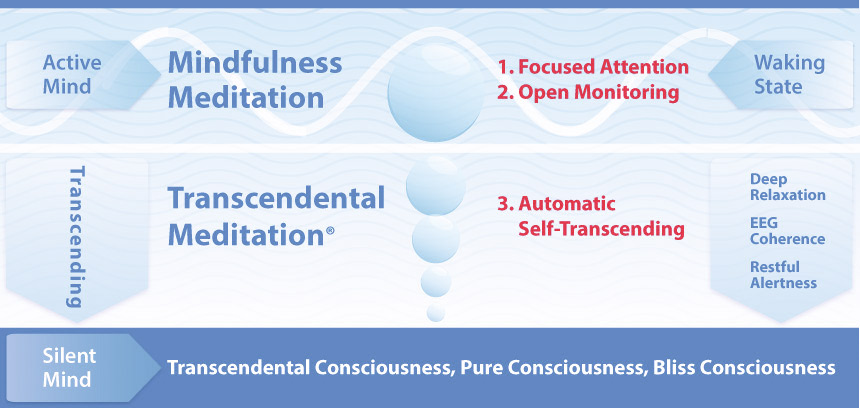
The evidence you can use
You’ll find good science on both sides. But if speed, depth of rest, and cardiometabolic implications matter to you, TM has unusually strong data for a single, standardized technique.
Stress and psychological distress
A randomized clinical trial of health-care workers found that three months of TM significantly reduced overall psychological distress versus control. That matters because health-care workers are, bluntly, some of the most stressed humans on earth. (JAMA Network)
Cardiovascular risk
The American Heart Association reviewed multiple meditation types and concluded TM can be considered in clinical practice to lower blood pressure—an unusual endorsement in a conservative field. Follow-on reviews highlight potential reductions in cardiovascular events among at-risk groups. Translation: we’re not just talking “I feel calmer,” but risk factors that your doctor tracks. (AHA Journals, PMC)
Brain coherence and cognitive performance
EEG studies report increased frontal coherence and distinctive patterns during and after TM that correlate with better attention and executive function. For knowledge workers, that’s productivity without the coffee jitters. (PubMed)
Mindfulness still shines
None of this knocks Mindfulness. Meta-analyses and large individual-participant reviews show meaningful improvements in anxiety, depression, stress, and overall distress—though effects vary and often depend on consistent practice and program quality. (PMC, Nature)
Real people, real quotes
Oprah Winfrey made TM a company-wide practice because she saw results. Her public note is simple and specific: “Twenty minutes in the morning, 20 in the evening… The results have been awesome. Better sleep… greater productivity and creativity all around.” That’s not brand copy—it’s Oprah summarizing why she paid to share TM with her team. (Oprah)
Jerry Seinfeld talks about TM as a survival tool during the pressure cooker years of his sitcom: a 20-minute lunch-break practice that, in his words, “saved” him. He also calls TM “the ultimate work tool” on Tim Ferriss’s show—because it reliably resets his nervous system so the brain can do its job. (GOOD, The Blog of Author Tim Ferriss)
A veteran’s turning point
World War II fighter pilot Jerry Yellin returned home with crippling post-traumatic stress. He struggled for decades—until he learned TM in the 1970s. He later helped start veteran programs so others could access it, crediting the practice with relieving symptoms that nothing else had touched. His story is part of the public record, as is the veteran-focused TM work he inspired. (Wikipedia)
Nurses on the front lines
During the pandemic, nurses trained in TM saw large and rapid drops in anxiety, burnout, and PTSD symptoms over three months. Duke University highlighted the approach as a promising strategy for clinician well-being, and a peer-reviewed study and news release reported more than a 50% decrease in anxiety among TM-trained nurses compared to controls. When a practice helps the people who help everyone else, pay attention. (Duke University School of Medicine, EurekAlert!)
A fair word on Mindfulness stories
Mindfulness has changed lives, too. The Guardian profiled Ken Lunn, who used mindfulness and Buddhist practice to navigate grief and chronic insomnia, eventually teaching others later in life. Academic interviews with MBSR graduates echo similar themes: greater self-awareness, kinder self-talk, and a steadier response to stress—especially when people keep up the practice. The catch is in that last phrase. (The Guardian, PMC)
What usually sticks for busy people
Two obstacles make or break a meditation habit: effort and feedback.
Effort
Mindfulness asks for active attention and gentle self-correction whenever the mind wanders. It’s powerful, but it can feel like work at the end of a long day. TM, by design, removes that friction. People often describe the first week of TM as “Oh—this is what deep rest feels like, on demand.” Quick wins build momentum.
Feedback
When you can feel a change after a few sessions—better sleep, calmer mornings, less reactivity—you’re more likely to keep going. That’s where TM’s data on rapid reductions in distress and physiologic stress reactivity are compelling. (JAMA Network)
A quick side-by-side (so you can decide faster)
| What you want | TM tends to deliver when… | Mindfulness tends to deliver when… |
|---|---|---|
| Faster stress relief | You want something effortless that you’ll actually do twice a day. | You can commit to a structured 8-week course and daily practice. |
| Measurable cardiometabolic impact | You care about blood pressure and downstream risk. | You’re focused primarily on emotional regulation and present-moment awareness. |
| Cognitive clarity for work | You want resets that boost focus without more caffeine. | You enjoy attention training and watching thoughts as they arise. |
| Stickiness | You prefer a standardized method with personal instruction. | You prefer free or app-based options and like self-guided learning. |
What about trauma, anxiety, or burnout?
For PTSD, TM has head-to-head and pilot trials suggesting strong benefits—even when compared with gold-standard exposure therapies—and without re-exposing patients to trauma content. For clinicians and first responders, that gentle approach can be a lifeline. As always, this is adjunctive support, not a replacement for medical care. (The Lancet, Wiley Online Library)
Mindfulness also has solid anxiety data—including noninferiority to escitalopram in a well-designed randomized trial. If you like the ethos of “be with what is” and want to integrate awareness into daily life, you’ll find a home there. (JAMA Network)
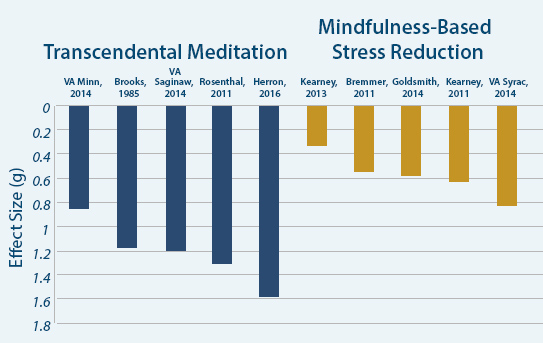
Cost, learning, and access
Mindfulness wins on accessibility. There are excellent free resources and reasonably priced courses. The big returns usually show up when you do a complete MBSR-style program or work with an experienced teacher, but apps can be a great start. (PMC)
TM requires instruction fees because it’s taught one-on-one in a standardized course. That said, scholarships and sliding-scale options exist through organizations like the David Lynch Foundation—especially for veterans, students, and health-care workers—precisely because the outcomes have been persuasive. (davidlynchfoundation.org)
A simple way to test both—without guessing
Try a week of TM if you can access instruction. Pay close attention to sleep quality, your morning mood, and how quickly you “come back to baseline” after stress. Look for tangible changes within days.
Then, the next week, practice basic mindfulness for 10–15 minutes daily. Use breath and body scans, and notice how often you remember to return gently to the present during your day. If you thrive on that awareness training, you’ll feel it.
Your body and calendar will tell you which one you’ll keep.
Why TM often wins for busy, high-responsibility lives
The more plates you’re spinning, the more you need a practice that doesn’t argue with your nervous system. TM’s ease, rapid feedback, and breadth of measured effects—stress, blood pressure, brain coherence—make it unusually compatible with modern reality. That’s why you see high-pressure performers and decision-makers sing its praises, from studios to trading floors to hospital units. (Oprah, The Blog of Author Tim Ferriss, AHA Journals)
A few myths, quickly cleared
“TM is just paying for a mantra.”
You’re paying for expert instruction in a standardized method that people consistently keep long-term. The mantra is one part of a complete, personalized teaching process with follow-up support.
“Mindfulness is slow, TM is fast.”
Sometimes. Mindfulness can create profound shifts—especially with good instruction and steady practice. But if you want noticeable relief fast and the path of least resistance to daily consistency, TM has the edge more often than not. (JAMA Network, PMC)
“You have to pick one forever.”
Nope. Many people use TM for deep daily rest and keep mindfulness moments as a way of living—pausing before hitting send, feeling the breath during a tense conversation, noticing beauty on a walk.
Final thought—and a gentle nudge
Meditation isn’t about becoming a different person. It’s about meeting life with a calmer nervous system and a clearer mind. If you crave something, you’ll do—and feel—TM is likely your best first bet. If you love the idea of training attention and weaving awareness into every task, you may fall in love with Mindfulness. Either way, you win.
If you’d like, I can tailor this for your audience and add a CTA that points readers to a certified TM teacher directory and a vetted list of reputable mindfulness courses in your area. I can also add an FAQ section (cost, time, religious neutrality, what sessions look like) and an SEO-friendly title tag and meta description.
Sources for stories and key claims (hand-picked)
• Oprah on her company’s TM routine and results. (Oprah)
• Jerry Seinfeld on TM as a “work tool” and how it sustained him. (The Blog of Author Tim Ferriss, GOOD)
• Veteran Jerry Yellin’s public account of TM and PTSD. (Wikipedia)
• TM randomized trial in health-care workers reducing psychological distress. (JAMA Network)
• TM and cardiovascular risk: American Heart Association statements and reviews. (AHA Journals, PMC)
• Brain coherence and TM. (PubMed)
• TM for nurses’ anxiety/burnout during COVID (study and news release). (Duke University School of Medicine, EurekAlert!)
• Mindfulness evidence base and variability of outcomes. (PMC, Nature)
• Mindfulness noninferior to escitalopram for anxiety disorders. (JAMA Network)
• A human mindfulness story (Ken Lunn) and qualitative follow-ups with MBSR completers. (The Guardian, PMC)
Q: Is Transcendental Meditation better than Mindfulness for beginners?
A: For many beginners, yes — TM is effortless and produces noticeable results quickly. Mindfulness can also be effective but may require more patience and practice to master.
Q: How long before I see results with TM?
A: Many people feel calmer and more rested within the first few sessions. Scientific studies show measurable stress reduction in as little as a few weeks.
Q: Do I need to sit cross-legged or chant to do TM?
A: No. You sit comfortably, close your eyes, and silently use your personalized mantra. No special postures or chanting are required.
Q: Can I learn TM from an app?
A: TM is taught one-on-one by certified instructors to ensure correct practice. Apps can’t teach the authentic TM technique.
Q: Is TM religious?
A: No. TM is secular and can be practiced by people of all faiths or none at all.
Q: Can I combine TM and Mindfulness?
A: Absolutely. Many people use TM for deep rest and Mindfulness for day-to-day awareness.
Q: Is TM expensive?
A: TM instruction has a course fee, but scholarships and sliding-scale rates are often available through certified centers.
Q: How is TM different from other mantra meditations?
A: TM uses specific mantras and a structured teaching process, backed by over 430 peer-reviewed studies.
Q: Will TM help with sleep?
A: Many practitioners report better sleep quality, and studies confirm improvements in restfulness and reduced insomnia.
Q: Do I need a quiet environment to practice TM?
A: Quiet helps, but TM can be practiced almost anywhere you can sit comfortably with your eyes closed.


